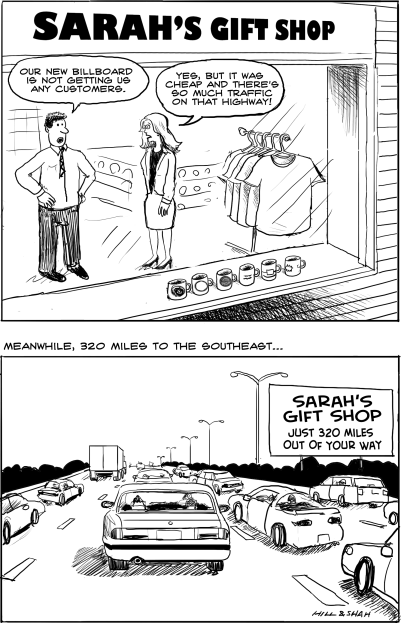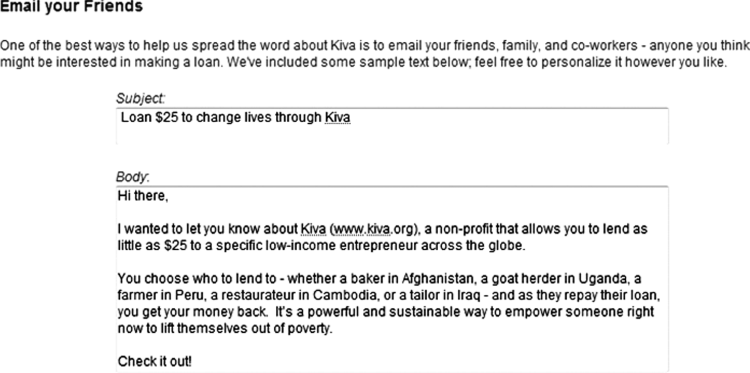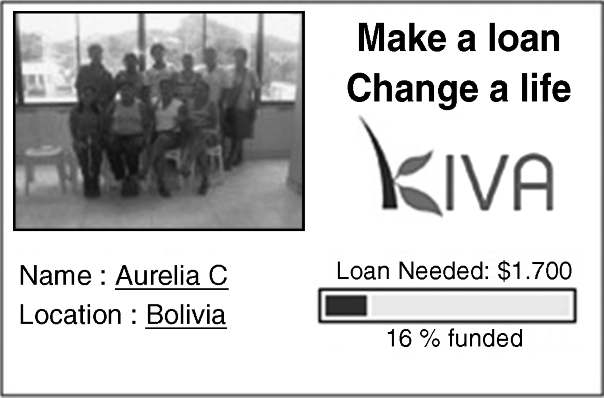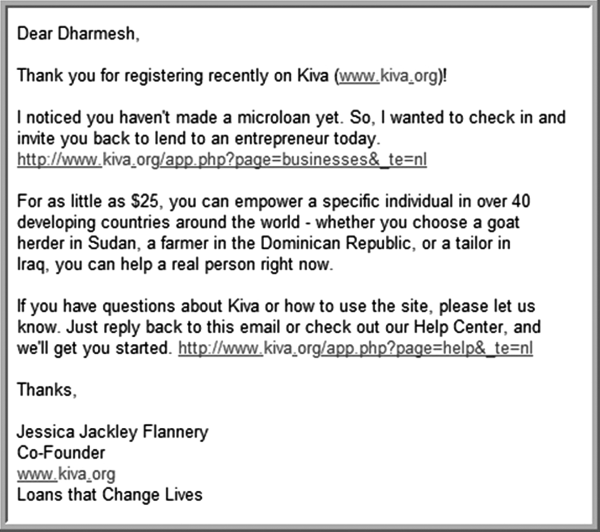Chapter 12
Convert Leads to Customers
Once you have a steady flow of leads coming in due to your inbound marketing efforts, you can then start to convert these leads into paying customers.
Grading and Scoring Your Leads
Not all inbound leads are created equal. They don't all close at a higher rate, faster, or with less effort than outbound leads. Depending on your business and your product/service, some inbound leads can close in as little as 15 minutes while others can take three to six months or more (this is especially true for B2B, where the sales cycle is much longer). It's important, then, to measure not just the quantity of leads, but the quality of your inbound leads in order to determine the effectiveness of your marketing and to allocate your time following up on your best leads. By quality we mean those leads that are likely to become good customers. You can be getting hundreds of leads every month but if these leads don't convert over time, you're either not creating the right kind of remarkable content targeted to your audience or you have offers that bring in lots of untargeted traffic that happens to convert.

To measure the quality of leads, you'll need to somehow grade them, with the higher value leads getting a better grade. You can use specialized software applications to automatically calculate the lead grade for you or you can manually grade leads yourself. Either way, the lead grade should be stored in your database along with the other information about your leads.
How should the inbound lead grade be calculated? There's no one answer to this. It depends on your business and how sophisticated a formula you want to use. The following are some of the factors that can go into the calculation of the lead grade.
Referral Channel
How did the lead find you? Did the person come via a Google search, a link from a blog, a social media site, or a link from your e-mail newsletter? The referral sources that have converted best in the past should influence this weighting. This means you'll need to either begin keeping track of your referral sources or go back and analyze your data if you do track this information. We recommend you analyze the previous two years of referral lead sources to see which generate the best leads for you.
Website Visits
Did the lead just visit your website once, or did they visit it many times? Did they visit recently or was it months ago? Did they look at specific web pages indicating that they're further along in the buying process? For example, someone who looked at your pricing page is likely to be a better lead than someone who looked at the management team bios.
Calls-to-Action Taken
Usually, a visitor becomes a lead by completing some call-to-action (such as completing a lead form). As we discuss in Chapter 6, you should have several types of calls-to-action on your site, with different forms, such as request a demo, download a white paper, request a call with a sales representative, and so on, because some lead forms generate higher value leads than others. Also, leads that completed more than one call-to-action are likely better qualified. If a lead downloaded a white paper, registered for a webinar, and requested a demo, that's likely a better lead than someone who had requested only one of those things.
Form Responses
On your lead forms, you often ask a series of questions. Examples include: Are you a small business or large enterprise? What industry are you in (financial services, healthcare, manufacturing)? Do you sell to consumers or businesses? Whatever the questions are, each tells you information about the lead. It's highly likely that certain types of leads (those that responded to questions in a certain way) are more qualified than others. If you're selling legal services primarily to large Fortune 500 companies with lots of different brands, someone who tells you that they're a small business is likely not a high-value lead. It is tempting to ask many questions on your lead forms simply to get better data on the leads, so that they can be graded more accurately. As discussed earlier, this is often a mistake. You should ask for the minimal amount of data that is just enough to make a reasonable quality assessment. Ask too many questions, and the web visitor won't become a lead in the first place and an opportunity is lost.
All of these factors can be combined into a predictive formula that calculates the lead grade based on the available data. You generally preconfigure this formula into your lead management software, assign specific points to various factors, and calculate a final grade based on those points. Another powerful approach is to use closed-loop grading. This refers to the ability to automatically infer the lead-grading formula by looking at the data of leads coming in historically.
Nurturing Your Leads
Based on the grade, some leads are qualified and ready to be handed to sales for follow-up. Other leads may not yet be ready to buy. Many businesses make the mistake of ignoring these leads or handing them to a sales rep who disqualifies them because they are not ready to buy this quarter. Because salespeople work on commission, their tendency is to pluck the “low hanging fruit” first—which is why they concentrate on closing sales with qualified leads and ignoring all others. This is unfortunate since there's a lot of value in these leads—because many of them will eventually buy. Therefore, if you don't stay in front of these leads on a consistent basis, there's a good chance these people will buy from a competitor who has been keeping in touch. The unqualified leads that weren't sent to a sales rep or disqualified should be placed into a lead nurturing program until they take further action that increases their grade enough to be handed (back) to a sales rep.
The idea behind lead nurturing is to maintain ongoing communication and dialog with these leads so that when they're ready to buy, your product is at the top of their minds. Nurturing leads often occurs only through e-mail, but it should include a variety of channels, as appropriate to your business, including phone calls. How often you stay in touch should be based on the length of your sales cycle. For example, if you're a B2B company with a complex sales cycle that extends over many months, you should probably limit yourself to one to two messages a month.
The nurturing program should involve different segments of leads. For example, the leads that came through your “download a white paper call to action” will get one set of messages while the leads that came through your industry trade show will get another. Just as you want your landing pages to be specific to your call-to-action, you want your nurturing messages to be specific to the call-to-action, as well.
The information that you send through your lead nurturing program should be useful and always include a compelling call-to-action. Similar to the blog content we described earlier, the content in your nurturing program shouldn't sell too hard. Leads in your nurturing program should want to hear from you because in each interaction with the lead, you should be creating value. A great example of remarkable content sent to us through a lead nurturing campaign comes from Venator Partners, one of many executive search firms in our area. We receive their nurturing e-mails weekly and are drawn in by a few of their remarkable features. For example, the e-mails always have a new inspirational quote, such as this one from Ralph Waldo Emerson: “Our greatest glory consists not in never falling…but in rising every time we fall.” The messages provide a comprehensive list of the previous week's IPO filings, venture fundings, and executive moves—incredibly useful information that's packed into one place. Included with this useful information is a graph plotting these three things over time (see Figure 12.1). Because their nurturing campaign is remarkable enough for us to look at each week, when we're ready to hire an executive search firm, Venator Partners will be one of the firms on our short list.

Figure 12.1 From Venator Partners Weekly E-Mail
We have a word of caution about spending lots of time or money on lead grading and nurturing. The problem most companies have is getting more leads, not sorting through the leads they have by grading and nurturing them. Before you spend days and weeks setting up fancy grading and nurturing systems, it is advisable to get your lead creation machine cranking first.
Broadening Your Reach
By doing the things we have been talking about so far in this book, you'll begin broadening your reach, a term that we use to describe the total number of marketing contacts you have. Traditionally, marketers think about their contact database as their e-mail and/or direct mail list, but with inbound marketing you should expand your definition to include all of the people you can reach through e-mail, blog subscriptions, Twitter, Facebook, LinkedIn, and other social networks.
When you want to influence your marketplace about something important, such as a new service offering, your reach should go beyond your e-mail list and expand to all of your followers. The major benefit of communicating with your market through channels like social media and blogs, rather than e-mail, is that your market is pre-programmed to ignore everything coming through e-mail as propaganda while relying on their colleagues and social media sites for new information. Your e-mail audience is unlikely to physically respond to an e-mail blast (especially when the e-mail address the message is coming from is noreply@yourcompany.com), but they are much more likely to engage by commenting back to you when they are notified about new offerings through social media contacts and your blog. Also, notices of new offerings sent through social media sites are much more likely to go viral. For example, if you announce your new service offering on Twitter and one of your followers tweets back, then their followers' attention will be drawn to your announcement. The same holds true for Facebook, LinkedIn, and your blog.
Tracking Your Progress
You can measure several things in the lead-to-customer conversion stage addressed in this chapter, but the most important one is how efficiently you are closing customers with your marketing efforts.
You can tweak your landing pages and conversion forms by measuring the conversion rate on your landing pages, to determine if you're leaking too many visitors and thus lowering your conversion rate. Often, creating more targeted content and simplifying the form can improve your conversion rate dramatically.
Finally, you should track the effectiveness of your lead-nurturing programs. For example, when you send an e-mail out to your list, how many of your subscribers actually click through on one of the links in the message? If you're selling a product, how many purchase it? Measuring how well your lead-nurturing programs are performing will help you get a better sense of the value of a lead, even when that lead is not yet ready to buy.
Inbound in Action: Kiva
Not-for-profit Kiva's mission is to connect people through lending for the sake of alleviating poverty. The organization's person-to-person micro-lending website empowers individuals to lend directly to unique entrepreneurs around the globe.
Kiva has built an exceptional level of reach in a relatively short period of time using inbound marketing. The kiva.org website is currently one of the top 10,000 websites in terms of traffic, according to Alexa, and has over 212,000 members in its Facebook group. By any measure, this is an online success story. But, what's particularly impressive is that they have done this with a relatively low budget (remember, inbound marketing is not about the “width of your wallet”).
Most non-profit websites simply state the organization's mission, and share some brochureware information (in many cases, the content is actually the same as the printed brochure!). Kiva goes well beyond that in getting their existing community to help extend their message.
One example is the “Email Your Friends” feature on the website. Kiva provides sample text that users can simply copy and paste—making it easy for people to tell their friends about Kiva. What's fascinating about their implementation is that it uses no special software. They kept it simple, but it accomplishes the goal (see Figure 12.2).

Figure 12.2 Screen Shot of Kiva's “Email Your Friends” Page
Kiva goes even further in getting help to spread their message. In addition to the ease of allowing people to e-mail their friends, Kiva also provides simple instructions on how to add the Kiva message to a person's e-mail signature. When a particularly loyal member of the community adds this message, every e-mail he or she sends out contains Kiva's message at the bottom of the e-mail.
For its more tech savvy community members, Kiva provides several ways to promote the organization on the web, the most impressive tactic being a dynamic banner/ad that users can add to their websites. Figure 12.3 shows an example.

Figure 12.3 Screen Shot of Kiva's Banner on Their website
We love this banner ad tactic for several reasons. Once the banner is installed on a website, the amount of traffic it generates for Kiva increases as that website grows, meaning Kiva is piggybacking on the success of its members' own websites. Second, the banner is dynamic and allows Kiva to show a specific call-to-action with a specific goal.
In addition to building their reach, Kiva also does a great job of nurturing that reach. For example, like many people, we were intrigued by the idea behind Kiva and registered right away. But, like many people, we didn't spend the time to go through the steps to actually make a loan due to becoming distracted with other things. A few days later, we received the following friendly e-mail from Kiva. (See Figure 12.4.)

Figure 12.4 Kiva E-Mail Reminder to Registrant
This e-mail worked because it was clearly sent only to users that had registered for the site, but not actually completed a loan. The e-mail included a specific call-to-action: “I wanted to check in and invite you back to lend to an entrepreneur today.” Third, Jessica recognizes that Dharmesh might not be ready to take the next step yet and offers more information and the ability to ask questions—by responding to the e-mail! The entire message has a casual but professional tone. It's effective in stating Kiva's goals, but does not sell too hard and is one of the best examples of proper lead nurturing we've seen.
To Do
- If you have dozens or hundreds of leads coming in, you should use the criteria above to grade them and then hand your qualified opportunities to your sales reps.
- If you have dozens or hundreds of leads coming in, you should segment and nurture your unqualified opportunities until they are ready for your sales organization.
- You should start measuring your market reach over time, including the number of e-mail addresses, blog subscribers, Twitter followers, LinkedIn group members, Facebook friends, and so on.
- ____________________________________________________
- ____________________________________________________
- ____________________________________________________